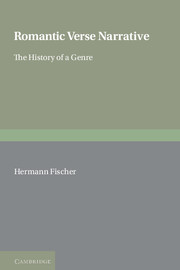Book contents
- Frontmatter
- Contents
- Preface
- List of abbreviations
- Dedication
- Introduction
- Part I The genre and it historical context
- Part II The history of the romantic tale in verse: poets, works, critics and the public
- 3 Early forms
- 4 The establishment of the genre by Sir Walter Scott, its fashionable period, and limitatins by other poets
- 5 ‘The postscript of the Augustans’ and the opposite of the romance
- 6 Ramification and dissolution
- 7 The subsequent fate of the genre
- Conclusion
- Notes
- Bibliography
4 - The establishment of the genre by Sir Walter Scott, its fashionable period, and limitatins by other poets
Published online by Cambridge University Press: 27 March 2010
- Frontmatter
- Contents
- Preface
- List of abbreviations
- Dedication
- Introduction
- Part I The genre and it historical context
- Part II The history of the romantic tale in verse: poets, works, critics and the public
- 3 Early forms
- 4 The establishment of the genre by Sir Walter Scott, its fashionable period, and limitatins by other poets
- 5 ‘The postscript of the Augustans’ and the opposite of the romance
- 6 Ramification and dissolution
- 7 The subsequent fate of the genre
- Conclusion
- Notes
- Bibliography
Summary
The romances of Sir Walter Scott
And find, to cheat the time, a powerful spell
In old romaunts of errantry that tell,
Or later legends of the Fairy-folk,
Or Oriental tale of Afrite fell,
Of Genii, Talisman, and broad-wing'd Roc
Though taste may blush and frown, and sober reason mock.
Walter Scott, Introduction to Harold the Dauntless, 18From quite different starting points, Landor, the Lake Poets and Southey came very close to the romantic literary form that was the natural, logical development of the tendencies described in chapter 2. All these poets, however, failed to achieve the breakthrough to the popular romance, for reasons we attempted to define in the section on early forms. It was Scott, finally, who was successful, and who was predestined as no other to discover this genre. He had that combination of qualities that was necessary in order to create the type of poetry that was the ‘inevitable’ development of what had gone before: he had a deep personal academic and literary relationship to the world of medieval singers and knights, which had to provide the inspiration for a new type of narrative poetry once classicism had lost its validity. Like the old minstrels, he took naive pleasure in the magic, horror and colourfulness of all ‘romantic’ happenings. He was not so sensitive that he shrank from the savagery of the aggressive world portrayed in the old romances, nor were his tastes so refined that he was repelled by the simple form of most of the old poetry.
- Type
- Chapter
- Information
- Romantic Verse NarrativeThe History of a Genre, pp. 86 - 119Publisher: Cambridge University PressPrint publication year: 1991



